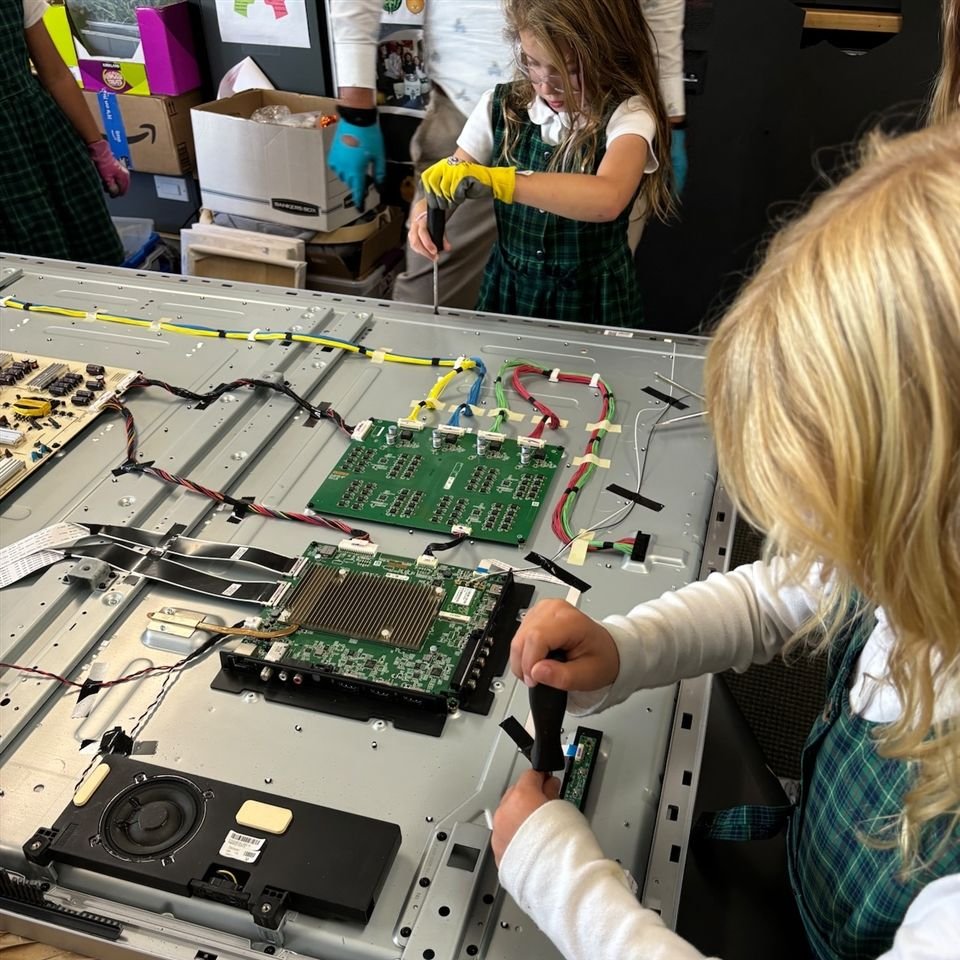August 2025
Burke’s School Third Graders Dive Into Repair
Jimmy Santosa was inspired by volunteering at Berkeley Unified School District’s Fix-it Fest and the teaching resources in our Educator Resource Library. With help from his students’ parents and grandparents as repair coaches, he offered a repair unit for his third grade makerspace classroom at Katherine Delmar Burke School in San Francisco, California, USA. Through hands-on fixing, his third graders learned about how things are made, the value of repair, and repair’s role in environmental sustainability.
The Burke’s school newsletter covered the culminating repair event. We’re republishing their article here, followed by more information about the school and its maker program.
”The Repair Clinic Is Open For Business!”
This essay was first published on Burke’s School’s website on 1/6/2025, and is shared here with their permission.
A ripped stuffed animal? Mechanical issues with a clock? Come find Burke’s third graders—they are repair professionals-in-training!
As part of Burke’s Strategic Plan work focused on education for sustainability, Lower School Makery teacher Jimmy Santosa is piloting a unit on repair as an alternative to purchasing new things. He was inspired by Vita Wells, founder of The Culture of Repair Project, who facilitates repair clinics at schools around the Bay Area. “Nurturing a mindset for repair emboldens people to care more deeply about the world, our belongings, and the systems in which we are all interconnected,” says Mr. Santosa. His goal is to instill a “can-do” attitude about fixing things and build community around helping others restore cherished items. He split this unit into three parts: 1) disassembling electronics in the “Breakery”; 2) sharing stories about the value of repair, and 3) hosting a community repair clinic.
The “Breakery”
In late October and early November, the Class of 2030 studied discarded toys, electronics, and other mechanisms by taking them apart. Items included robotic dogs, cell phones, coffee machines from home, old Macbooks, printers, and a huge flat-screen television donated by the Tech department! The third graders gained confidence using screwdrivers, tweezers, and arm strength to take everything apart.
Seeing the inside of common electronics sparked their curiosity. They began to ask many questions, many of which began with “What do these parts do?” and ended with “Will this work if I put it back together?”. The third graders wrote down their observations and made predictions about how things worked.
Charlotte ‘30 discovered after taking apart a toy piano—it’s not just all wires underneath. “These pieces are just hot glued together! I can rip them out easily!”
Learning From Experts
In mid-November, Burke’s parent Paul Marshall was invited to share his expertise with repair as a professional piano technician and tuner. His presentation sparked classroom excitement as most students, even the piano players, had never seen the inner workings of a piano.
Mr. Marshall brought spare piano parts for everyone to examine and piece together. The class was amused to find that some parts had names like parts of a finger—phalanges and knuckles! Students were thrilled to look inside the school’s grand piano and see hammers moving when the keys were pressed.
“Repairing is meaningful work,” Mr. Marshall asserted, and the third graders nodded their agreement, adding that repairing can take on different forms, from something physical like piano parts and cars to something intangible like friendships and relationships. “Repairing can mean mending something that was once ‘whole.’”
The Repair Clinic
In December, the third graders were buzzing with anticipation—the time had finally come to fix their objects from home! With the support of twelve parent and grandparent volunteers, students worked in small groups to share stories about their objects and explain their importance. Students brought in stuffed animals, jewelry, broken picture frames, and toys that had sentimental value.
Groups discussed the problems and then determined an approach for repair. With a plethora of different tools at their disposal, including screwdrivers, glues, and needles and thread, the third graders worked carefully with parents to repair most of the items. The first week was so successful that Mr. Santosa solicited Lower School teachers to bring in their broken items. The Repair Clinic expanded to be of service to the Burke’s community!
Hazel ‘30 found great satisfaction in the Repair Clinic, having sewn a teacher’s torn pants pocket and re-connecting her favorite keychain. Every time she repaired an item, she got to ring a bell and hold up a “REPAIRED” sign to announce her accomplishment to the class. Proudly holding up her items, she explains what repair means to her: “You don’t have to throw old or broken things away. You can repair them back up and use them again. It’s a good thing!”
Whether it was repairing household objects, clothes, or toys, the third graders worked adeptly to glue, sew, and restore their cherished items. Teachers who had repairs done were impressed with the quality of the work and were deeply appreciative. The repair clinic is officially open!
Katherine Delmar Burke School Makery, San Francisco, California USA
Playing a prominent role in Burke’s academic program, Burke’s Makery occupies two dedicated makerspace classrooms, and is a place to feel agency, experience the joy of learning, and celebrate community. On any day, you might find students in the Makery building with cardboard, making gifts for family members, sewing, operating the laser cutter, coding, or recording videos. In October, teachers are busy in the Makery as well, working on Halloween costumes.
Makery is a dedicated class, and Jimmy Santosa teaches kindergarten through fourth-grade once a week or more frequently for special projects. Student work is often integrated with the curriculum across the Lower School. Open Make sessions are offered during recess time, where students may work on projects of their choosing.
What drew Jimmy to Burke’s is his respect for the Makery program and how it is an integral part of the school’s Mission. “Burke's committed to this innovative program over fifteen years ago, and I see how Makery helps to educate, encourage, and empower girls. The Makery Mindset can be witnessed whenever Burke’s students or teachers are willing to get hands-on and accept mistakes as part of the learning process. Coming to Burke’s was a unique opportunity to teach many of the things I love in a supportive community.”
Jimmy Santosa is entering his fifth year as the Lower School Makery Facilitator and Technology Integration Specialist at Katherine Delmar Burke School in San Francisco, California, USA. He earned both bachelor’s and master's degrees in Mechanical Engineering from the University of Michigan-Ann Arbor. He was recruited to California to work in the semiconductor industry and was a mechanical engineer at Applied Materials for eight years.
Jimmy was later drawn to teaching and received his teaching credential through San Francisco State University and Bay Area Teacher Training Institute. He has over fifteen years of experience in education, having taught kindergarten, middle school science, and technology at the Cathedral School for Boys, also in San Francisco. He serves on the board for Bay Area Teacher Training Institute as well as the board of the San Francisco Pride Band, where he plays saxophone and bassoon.






